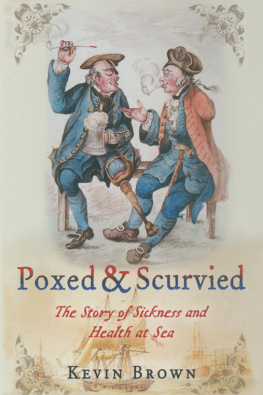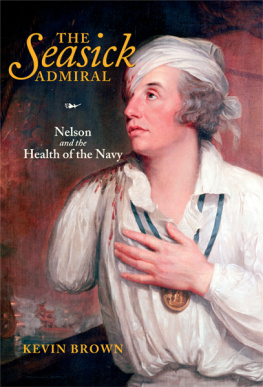Copyright Kevin Brown 2011
First published in Great Britain in 2011 by
Seaforth Publishing,
Pen & Sword Books Ltd,
47 Church Street,
Barnsley S70 2AS
www.seaforthpublishing.com
British Library Cataloguing in Publication Data
A catalogue record for this book is available
from the British Library
ISBN 978 1 84832 063 5
All rights reserved. No part of this publication may be reproduced
or transmitted in any form or by any means, electronic
or mechanical, including photocopying, recording,
or any information storage and retrieval system, without
prior permission in writing of both the copyright
owner and the above publisher.
The right of Kevin Brown to be identified as the author
of this work has been asserted by him in accordance with the
Copyright, Designs and Patents Act 1988.
Typeset and designed by M.A.T.S. Leigh-on-Sea, Essex
Printed and bound by CPI Antony Rowe, Great Britain
FOR MANY PEOPLE their first exposure to the whole subject of medicine at sea may well once have come on a visit to HMS Victory in the days when fresh-faced young naval ratings gave guided tours of the ship, and dwelt with particular bloodthirsty relish on the death of Nelson and the conditions in which the surgeon amputated limbs in the cockpit; painted red to hide the blood. The details may not have been altogether accurate, but the imagination never failed to be stirred. What perhaps made such a tour even more memorable was that the guide; for all his youthful enthusiasm, visibly stood in a long but living naval tradition, and was a link in the chain from the days of Nelson that is missing now that the visitor can go around the Admirals flagship unescorted and explore at his own pace. Yet even now standing in the place where it all happened, and seeing for oneself the conditions in which the seaman lived, worked, and died, and where his wounds and illnesses were treated, can still stir the imagination. Happily there are many historic ships all over the world that evoke our nautical heritage and where it is possible to visualise the daily environmental threats to the health of the mariner, and better understand the achievement of staying well at sea. Such vessels as the Mary Rose, the Vasa, HMS Warrior, HMS Belfast, and the Cutty Sark, to name only a few, cannot fail to inspire an interest in the past. The spark for this book came during a visit to the Royal Navy Submarine Museum at Gosport, when the guide, an ex-submariner, made the throwaway remark that the only medical care on board the submarine Alliance had been from the coxswain who had enjoyed about four hours training in first aid. That made me think of the problems of health and medicine at sea, far away from the medical facilities we all take for granted, the diseases caused by confined living and hazardous working conditions at sea, and the way in which ships can carry infection from place to place, including sexual ones carried by sailors with girls in many ports. It also made me want to write about the subject.
As well as the death of Nelson, the other commonly known fact about maritime medicine, dimly remembered by most people from schooldays, is the scourge of scurvy from which the sailor was saved by lemons and limes. Apart from there being much more to the story of the conquest of scurvy than the usual inaccurate summary of it, there is also a greater breadth and depth to the history of maritime medicine in general. Keeping well at sea has always been a problem since man first sailed across the ocean, and has been affected by changes to ship design, the introduction of new technology, new ways of waging war in naval vessels, and developments in medicine and society in the wider world. Naval hygiene and medicine were to be important in building up the British Empire and in establishing British naval ascendancy in the eighteenth and nineteenth centuries. Not only was there the problem of what to do without any access to medical facilities ashore for sick and injured sailors isolated in the middle of the ocean, but there were also health dangers arising from the very fact of being at sea. Ships are confined spaces in which disease can spread quickly among ill-nourished seamen crowded together. In such conditions doctors were often all at sea in more senses than one.
The medical and surgical journals of Royal Navy doctors serving at sea are a wonderful source of evocative first-hand accounts of the challenges faced by doctors on board ships which deserve to be more widely known about and studied. Now held at the National Archives at Kew, these journals, surviving from the late eighteenth century, record more than just the daily illnesses and wounds of a ships company, but also include accounts of natural history and sociological studies of indigenous cultures encountered on voyages. Some surgeons even included sketches and watercolours in their journals. There are also journals written by surgeons on convict ships and government-sponsored emigrant vessels. Some of them have literary merit. All of them provide insights into medicine at sea in peace and war. Sir Henry Dale in his preface to the first volume of John Keevils 1957 Health of the Navy was spot on in stating that the naval medical records are unique in their long continuity, and present the material for a study of by far the earliest of public attempts to organize a health service. In the isolation of a vessel at sea, health experiments for the communal good could be conducted on a captive population subject to naval discipline.
No one working on such a subject as this can remain an island unto himself, and I wish to thank the many people who have assisted me in ways both large and small. Timothy Hall arranged for access to the site of the Royal Hospital Haslar after its closure and gave me an exhaustive tour of the buildings and grounds, informed by his experiences as a dental officer there. He also obtained access for me to the Historical Library of the Institute of Naval Research. In Malta I am grateful to the security staff who listened to my request to walk around the site of Bighi Hospital, and allowed me to see the crumbling remains of what was once the largest British naval hospital in the Mediterranean. Sally Bell, Clinical Quality Consultant to P&O Princess Cruises and Secretary of the International Maritime Health Association, has been an invaluable source of contacts and kindly arranged for me to attend an open day for the recruitment of medical staff on board the Queen Mary II, organised by Maggie Blight, which gave me an insight into the role of doctors and nurses on cruise ships. I also wish to thank for their help, interest and support: Gale Lewis; Neil Handley; Marika Hedin, Director of the Vasa Warship Museum; Evi Kalodiki, who shared her memories of being a ships doctor on a cruise liner; Charles Savona-Ventura in Malta; Tim Carter, Chief Medical Advisor to the Maritime and Coastguard Agency; Carter D Hill, Medical Director of the Holland-America Line; Johann Onnink, Manager of Nautical Operations and Administration of the Holland-America Line; Jane Wickenden, Historic Collections Librarian at the Institute of Naval Medicine; Lorenzo Glavici, Communications Manager, Brioni SpA; and Robert Gardiner of Seaforth Publishing. I also wish to acknowledge the work of the staff of the various archives, libraries and museums I have visited and consulted in the course of my research, whose behind the scenes work of collection, preservation and cataloguing ensures that we have access now and for the future to wonderful resources for the study of our naval and maritime heritage.










